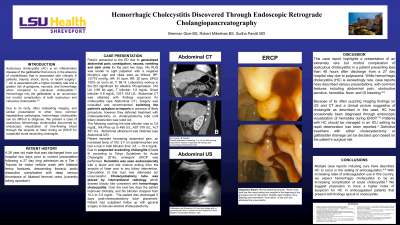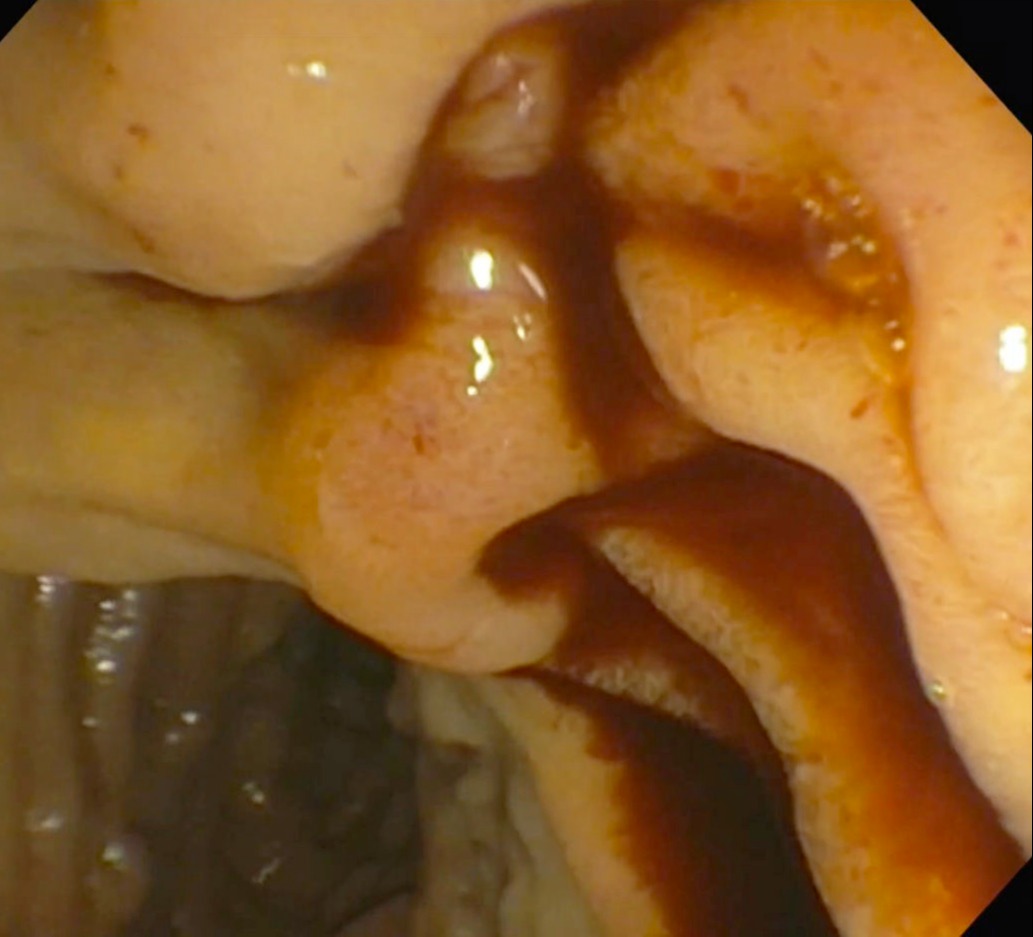Monday Poster Session
Category: Biliary/Pancreas
P1556 - Hemorrhagic Cholecystitis Discovered Through Endoscopic Retrograde Cholangiopancreatography
Monday, October 23, 2023
10:30 AM - 4:15 PM PT
Location: Exhibit Hall

Has Audio
- BG
Brennan Gioe, BS
LSU Health, School of Medicine
Shreveport, LA
Presenting Author(s)
Brennan Gioe, BS1, Robert Miketiinas, BS1, Sudha Pandit, MD2
1LSU Health, School of Medicine, Shreveport, LA; 2LSU Health Sciences Center, Shreveport, LA
Introduction: Hemorrhage into the gallbladder is an uncommon but morbid complication of both acalculous and calculous cholecystitis.1-2 Due to its rarity, often misleading imaging, and similar presentation to other more common hepatobiliary pathologies, hemorrhagic cholecystitis can be difficult to diagnose. We present a case of hemorrhagic cholecystitis discovered by endoscopic visualization of free-flowing blood through the ampulla of Vater during an ERCP for suspected ascending cholangitis.
Case Description/Methods: A 26-year-old male presented to the emergency department with abdominal pain, nausea, vomiting, and dark urine. The patient had a recent history of a polytrauma complicated by bilateral femoral DVT. Laboratory workup in the ED significant for Alk Phos: 316 U/L,T bilirubin: 1.8 mg/dL, D bilirubin: 0.8 mg/dL, GGT: 433 U/L. Abdominal CT scan was equivocal for cholecystitis. Surgery was consulted and recommended switching the patient’s apixaban to heparin in advance of likely procedure. The following day the patient's condition worsened with increasing abdominal pain and T bilirubin rising to 10.4 mg/dL. Due to suspected ascending cholangitis, an emergent ERCP was performed, revealing hemobilia with a blood and bile mixture exiting from the ampulla of Vater. The patient was diagnosed with acalculous hemorrhagic cholecystitis and treated with a cholecystostomy tube due to unsuccessful biliary cannulation. The patient improved clinically the following morning, with T bilirubin levels dropping to 3.9 mg/dL.
Discussion: This case report highlights the presentation of an extremely rare but morbid complication of acalculous cholecystitis in a patient on anticoagulation. With increasing rates of anticoagulation use in this country, we expect hemorrhagic cholecystitis to be an increasing complication of acute cholecystitis. We suggest physicians to have a higher index of suspicion for HC in anticoagulated patients that present with findings typical of cholecystitis.
References:
1. Jiang G, Bingmer K, Ammori J. Hemorrhagic Cholecystitis. ACS Case Reviews in Surgery. Vol.2 No. 5. May 2020
2. Hasegawa T, Sakuma T, Kinoshita H, et al. A Case of Hemorrhagic Cholecystitis and Hemobilia Under Anticoagulation Therapy. Am J Case Rep. 2021; 2021 Jan 9.

Disclosures:
Brennan Gioe, BS1, Robert Miketiinas, BS1, Sudha Pandit, MD2. P1556 - Hemorrhagic Cholecystitis Discovered Through Endoscopic Retrograde Cholangiopancreatography, ACG 2023 Annual Scientific Meeting Abstracts. Vancouver, BC, Canada: American College of Gastroenterology.
1LSU Health, School of Medicine, Shreveport, LA; 2LSU Health Sciences Center, Shreveport, LA
Introduction: Hemorrhage into the gallbladder is an uncommon but morbid complication of both acalculous and calculous cholecystitis.1-2 Due to its rarity, often misleading imaging, and similar presentation to other more common hepatobiliary pathologies, hemorrhagic cholecystitis can be difficult to diagnose. We present a case of hemorrhagic cholecystitis discovered by endoscopic visualization of free-flowing blood through the ampulla of Vater during an ERCP for suspected ascending cholangitis.
Case Description/Methods: A 26-year-old male presented to the emergency department with abdominal pain, nausea, vomiting, and dark urine. The patient had a recent history of a polytrauma complicated by bilateral femoral DVT. Laboratory workup in the ED significant for Alk Phos: 316 U/L,T bilirubin: 1.8 mg/dL, D bilirubin: 0.8 mg/dL, GGT: 433 U/L. Abdominal CT scan was equivocal for cholecystitis. Surgery was consulted and recommended switching the patient’s apixaban to heparin in advance of likely procedure. The following day the patient's condition worsened with increasing abdominal pain and T bilirubin rising to 10.4 mg/dL. Due to suspected ascending cholangitis, an emergent ERCP was performed, revealing hemobilia with a blood and bile mixture exiting from the ampulla of Vater. The patient was diagnosed with acalculous hemorrhagic cholecystitis and treated with a cholecystostomy tube due to unsuccessful biliary cannulation. The patient improved clinically the following morning, with T bilirubin levels dropping to 3.9 mg/dL.
Discussion: This case report highlights the presentation of an extremely rare but morbid complication of acalculous cholecystitis in a patient on anticoagulation. With increasing rates of anticoagulation use in this country, we expect hemorrhagic cholecystitis to be an increasing complication of acute cholecystitis. We suggest physicians to have a higher index of suspicion for HC in anticoagulated patients that present with findings typical of cholecystitis.
References:
1. Jiang G, Bingmer K, Ammori J. Hemorrhagic Cholecystitis. ACS Case Reviews in Surgery. Vol.2 No. 5. May 2020
2. Hasegawa T, Sakuma T, Kinoshita H, et al. A Case of Hemorrhagic Cholecystitis and Hemobilia Under Anticoagulation Therapy. Am J Case Rep. 2021; 2021 Jan 9.

Figure: Blood mixed dark bile flow noted exiting from ampulla in the beginning of the procedure prior to intervention
Disclosures:
Brennan Gioe indicated no relevant financial relationships.
Robert Miketiinas indicated no relevant financial relationships.
Sudha Pandit indicated no relevant financial relationships.
Brennan Gioe, BS1, Robert Miketiinas, BS1, Sudha Pandit, MD2. P1556 - Hemorrhagic Cholecystitis Discovered Through Endoscopic Retrograde Cholangiopancreatography, ACG 2023 Annual Scientific Meeting Abstracts. Vancouver, BC, Canada: American College of Gastroenterology.
